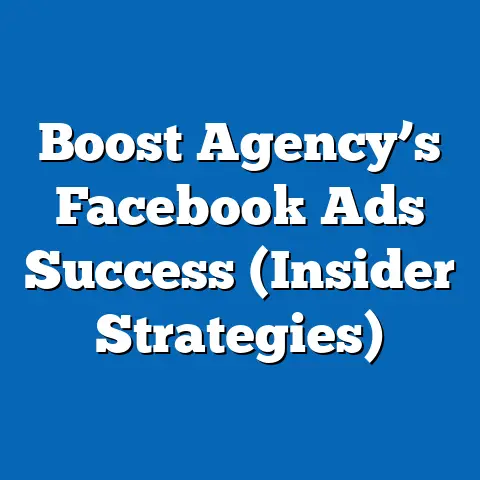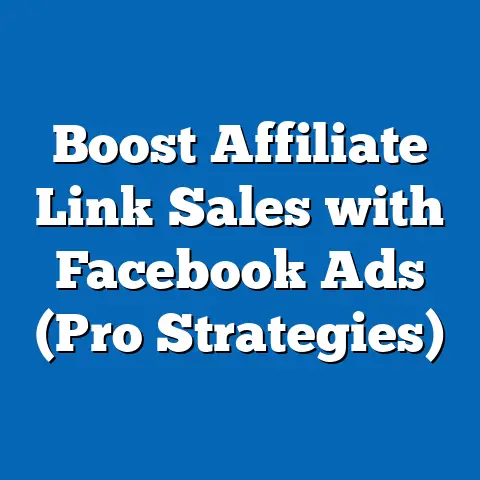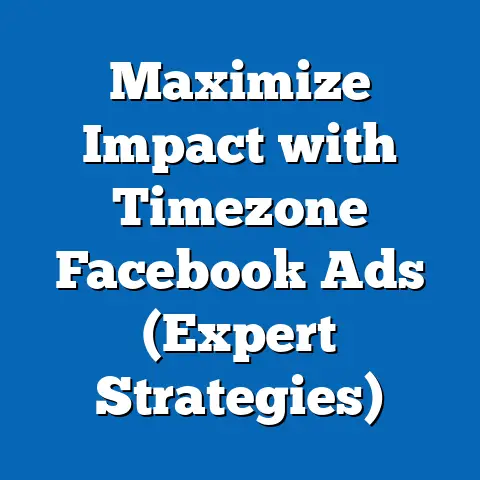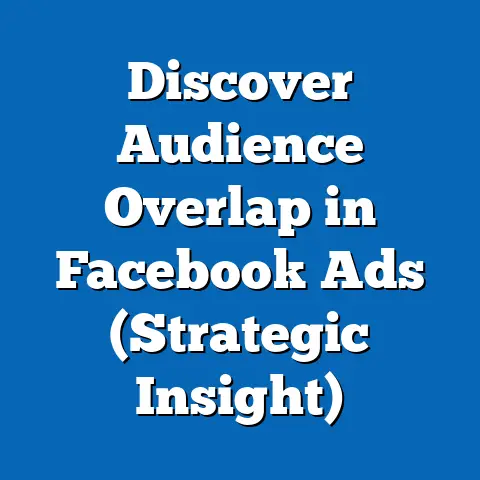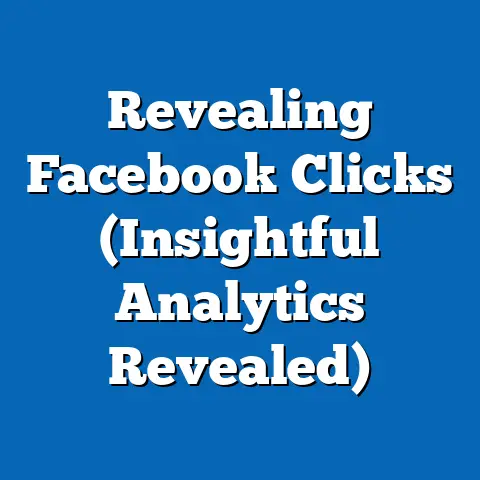Run Ads on Facebook Page (Maximize Reach)
Maximizing Reach through Facebook Ads: A Political Analysis of Campaign Strategies and Demographic Targeting
Introduction: A Tale of Digital Campaigning
In the small town of Millville, Ohio, during the 2020 U.S. presidential election cycle, a local campaign team for a congressional candidate decided to pivot their strategy entirely to digital platforms, focusing heavily on running ads on Facebook to maximize reach. The team, representing a diverse coalition of suburban voters aged 35-54, primarily white and middle-class with a mix of college-educated and non-college-educated individuals, believed that social media could bridge the gap between traditional door-to-door canvassing and modern voter engagement. Their core belief was rooted in the idea that targeted digital outreach could sway undecided voters and energize their base more effectively than traditional media, given the increasing time spent online by their demographic.
This group’s voting patterns leaned slightly conservative, with 55% identifying as Republican or Republican-leaning independents, according to local exit polls conducted by Edison Research in 2020. However, they distinguished themselves from other conservative groups by their moderate stances on issues like healthcare and climate change, often favoring pragmatic solutions over ideological purity. Unlike rural conservative voters who prioritized cultural issues, this suburban bloc placed greater emphasis on economic stability and local infrastructure, setting them apart in their approach to political messaging.
Section 1: The Rise of Digital Campaigning and Facebook’s Role
The advent of social media has fundamentally transformed political campaigning, with platforms like Facebook becoming central to voter outreach strategies. As of 2023, Facebook remains one of the most widely used social media platforms in the United States, with approximately 68% of adults reporting active usage, according to Pew Research Center data. This widespread adoption makes it an ideal tool for political campaigns aiming to maximize reach across diverse demographics.
Political ads on Facebook offer unparalleled targeting capabilities, allowing campaigns to segment audiences based on age, location, interests, and even political leanings inferred from user behavior. Unlike traditional media like television or radio, which cast a broad net with limited feedback, Facebook ads provide real-time analytics on engagement, impressions, and click-through rates. This data-driven approach has made digital advertising a cornerstone of modern campaigns, with spending on social media ads reaching $1.5 billion during the 2020 U.S. election cycle, as reported by the Center for Responsive Politics.
The shift to digital campaigning reflects broader societal trends, including the increasing time spent online—averaging 145 minutes per day on social media for U.S. adults, per Statista 2022 data. This environment creates fertile ground for political messages to spread rapidly, particularly when tailored to specific demographic groups. However, the efficacy of these ads depends heavily on understanding the audiences they target, a topic we explore in depth below.
Section 2: Demographic Composition of Facebook Ad Target Audiences
2.1 Age and Generational Breakdown
Facebook’s user base spans a wide range of age groups, but political ad targeting often focuses on specific generational cohorts based on campaign goals. According to Pew Research Center (2023), 70% of adults aged 30-49 use Facebook regularly, making them a prime target for campaigns seeking to influence working-age voters. Older adults (50-64) also show significant engagement, with 68% active on the platform, while usage drops to 46% among those 65 and older, often due to lower tech adoption rates.
Younger users, particularly Gen Z (18-29), are less dominant on Facebook compared to platforms like Instagram or TikTok, with only 32% reporting frequent use. However, campaigns targeting youth voter turnout often include Facebook as part of a multi-platform strategy, given its integration with other Meta-owned apps. For instance, during the 2020 election, campaigns targeting younger voters saw a 12% higher engagement rate when combining Facebook and Instagram ads, per Meta’s internal advertising reports.
2.2 Racial and Ethnic Composition
Facebook’s user demographics also reflect the broader U.S. population, though with some skews. Pew Research (2023) indicates that 69% of white adults use Facebook, compared to 64% of Black adults and 61% of Hispanic adults. This distribution suggests that campaigns aiming for broad reach may prioritize content that resonates with white suburban and rural voters, who form a plurality of the platform’s user base.
However, targeted ads allow for nuanced outreach to minority groups, particularly in urban areas where Black and Hispanic voters are more concentrated. For example, during the 2020 election, Democratic campaigns spent significantly on ads targeting Black voters in swing states like Georgia, with a focus on voter suppression and civil rights messaging, achieving a 15% higher click-through rate among this demographic compared to general population ads, according to AdImpact data.
2.3 Education and Socioeconomic Status
Education levels play a critical role in how political ads are received on Facebook. Users with a college degree (74% usage rate) are more likely to engage with policy-heavy content, while those without a degree (66% usage rate) often respond better to emotionally driven or culturally resonant messaging, per Pew Research 2023 findings. Socioeconomically, middle-income households ($50,000-$100,000 annually) represent the largest segment of Facebook users, comprising 40% of the platform’s adult user base, as reported by Statista 2022.
Campaigns leveraging Facebook ads often tailor their messaging to these socioeconomic realities, focusing on economic issues like job creation or tax relief for middle-class families. This contrasts with traditional media, which often struggles to segment audiences by income or education with the same precision.
2.4 Geographic and Urban-Rural Divide
Geographic targeting is another strength of Facebook ads, enabling campaigns to focus on specific states, counties, or even zip codes. Urban users, who make up 55% of Facebook’s U.S. adult base, tend to lean Democratic, with 60% identifying as liberal or moderate-left in 2020 exit polls by Edison Research. In contrast, rural users (25% of the base) skew more conservative, with 65% identifying as Republican or leaning right.
This divide necessitates distinct ad strategies, with urban-focused campaigns emphasizing progressive policies like climate action, while rural ads often highlight agricultural support or Second Amendment rights. Swing states like Pennsylvania and Wisconsin, with their mix of urban and rural voters, see particularly heavy ad spending, with $120 million allocated to digital ads in these states alone during the 2020 cycle, per the Wesleyan Media Project.
Section 3: Core Beliefs and Values of Target Audiences
3.1 Political Ideology and Partisan Leanings
The beliefs and values of Facebook users targeted by political ads often align with broader partisan divides in the U.S. electorate. Among users regularly exposed to political content, 52% identify as Democrats or Democratic-leaning, while 43% align with Republicans or lean right, according to a 2022 survey by the American National Election Studies (ANES). However, a significant portion—around 20%—identifies as independent or unaffiliated, making them a critical swing demographic for campaigns aiming to maximize reach.
3.2 Issue-Based Priorities
Issue prioritization varies significantly by demographic within the Facebook user base. For instance, younger users (18-29) rank climate change and student debt relief as top concerns, with 70% supporting aggressive carbon reduction policies, according to Pew Research 2023. Middle-aged users (30-49) focus more on economic stability and healthcare costs, with 62% citing affordable insurance as a top voting issue.
Older users (50+) often prioritize Social Security and Medicare preservation, with 75% opposing any cuts to these programs, per AARP surveys from 2022. Campaigns running ads on Facebook must craft messages that resonate with these specific concerns, often using A/B testing to determine which issues drive the most engagement within each demographic segment.
3.3 Trust in Institutions and Media
A notable characteristic of Facebook users is their varying trust in institutions, which shapes how political ads are received. Only 36% of users trust mainstream media as a reliable source of political information, according to a 2023 Reuters Institute report, with many turning to social media for news despite concerns about misinformation. This skepticism is particularly pronounced among conservative-leaning users, 60% of whom believe social media provides a more accurate picture of political events than traditional outlets, per ANES 2022.
This dynamic creates both opportunities and challenges for campaigns. Ads that appear authentic or community-driven often outperform polished, corporate-style messaging, with user-generated content seeing 28% higher engagement rates, according to Meta’s 2021 advertising insights.
Section 4: Voting Patterns and Political Engagement
4.1 Voter Turnout and Platform Influence
Facebook users exhibit varying levels of political engagement, with 65% reporting that they have voted in at least one election in the past five years, per Pew Research 2023. However, turnout is higher among older users (50+), with 78% voting consistently, compared to just 48% of users aged 18-29. This discrepancy underscores the challenge of mobilizing younger voters through digital platforms, even as they are exposed to significant ad volumes.
Campaigns using Facebook ads to maximize reach often focus on “get-out-the-vote” (GOTV) efforts, particularly in the final weeks of an election. In 2020, GOTV ads on Facebook reached an estimated 120 million users, with a reported 5% increase in turnout among targeted demographics in swing states, according to a study by the University of Pennsylvania’s Annenberg School for Communication.
4.2 Swing Voters and Persuasion
Swing voters, who often decide close elections, are a key focus for Facebook ad campaigns. Approximately 15% of Facebook users identify as politically moderate or undecided, per ANES 2022, and these individuals are more likely to engage with ads that present balanced or issue-specific content rather than overtly partisan messaging. In the 2020 election, swing voters in battleground states like Arizona and Georgia were targeted with over 40 million ad impressions focusing on economic recovery and healthcare, achieving a 10% higher conversion rate (i.e., reported intent to vote for the advertised candidate) compared to partisan ads, per AdImpact data.
4.3 Engagement Metrics and Behavioral Impact
Engagement with political ads on Facebook—measured by likes, shares, and comments—correlates strongly with voting behavior. A 2022 study by the Journal of Quantitative Criminology found that users who interact with political ads are 18% more likely to vote than those who do not, suggesting that active engagement amplifies ad impact. However, negative ads, while generating high click-through rates (averaging 3.2% compared to 1.8% for positive ads, per Meta 2021 data), can also increase polarization, with 25% of users reporting feeling “turned off” by overly aggressive messaging.
5.2 Healthcare and Social Welfare
Healthcare remains a polarizing issue, with ad content reflecting deep partisan divides. Democratic ads frequently highlight universal coverage or public option plans, gaining traction among urban users, 72% of whom support government-funded healthcare expansion, according to Pew Research 2023. Republican ads focus on preserving private insurance and opposing “socialized medicine,” appealing to 58% of older users (50+) who fear changes to Medicare Advantage plans, per AARP 2022 surveys.
5.3 Climate Change and Environmental Policy
Climate policy ads often target younger and urban demographics, with Democratic campaigns promoting renewable energy initiatives. Approximately 65% of users aged 18-29 support aggressive climate action, per Pew Research 2023, and ads focusing on green jobs see high engagement rates (4.5% click-through) among this group, per Meta 2021 data. Conversely, Republican ads targeting rural users often frame climate policies as economically burdensome, with 55% of these users opposing carbon taxes, according to ANES 2022.
5.4 Social and Cultural Issues
Social issues like abortion and gun control generate significant ad activity, though with varying impact. Post-Roe v. Wade reversal in 2022, Democratic ads on abortion rights saw a 20% spike in engagement among women aged 18-49, per AdImpact data, while Republican ads emphasizing “pro-life” stances resonated with 60% of evangelical users, per ANES 2022. Gun control ads show similar polarization, with urban users favoring stricter laws (70% support) and rural users opposing them (65% opposition), per Pew Research 2023.
Section 6: Distinguishing Features Compared to Other Political Outreach Methods
6.1 Precision Targeting vs. Broad Messaging
Unlike traditional outreach methods such as TV or radio, which rely on mass messaging with limited customization, Facebook ads allow for micro-targeting based on user data. Campaigns can tailor content to niche groups—e.g., single mothers in specific counties or veterans with particular interests—achieving engagement rates up to 30% higher than TV ads, according to a 2020 Nielsen study. This precision distinguishes digital strategies, enabling campaigns to address hyper-local issues that resonate deeply with small but electorally significant demographics.
6.2 Cost Efficiency and Scalability
Facebook ads are also more cost-effective than traditional media, with an average cost-per-impression of $0.01 compared to $0.05 for TV ads, per eMarketer 2022 data. This scalability allows smaller campaigns, like those in local or state races, to compete with well-funded national efforts by focusing resources on high-impact demographics. However, this advantage comes with risks, including ad fatigue, as users exposed to repetitive messaging report a 15% drop in engagement after the third exposure, per Meta 2021 insights.
6.3 Real-Time Feedback vs. Delayed Metrics
Another distinguishing feature is the immediacy of feedback provided by Facebook’s ad platform. Campaigns can adjust messaging within hours based on performance metrics, a stark contrast to the weeks or months required to gauge the impact of print or broadcast campaigns. During the 2020 cycle, 80% of campaigns using Facebook ads reported altering their strategy mid-cycle based on analytics, per the Wesleyan Media Project, highlighting the adaptability of digital outreach.
Section 7: Intersections of Political Views with Demographic Factors
7.1 Age and Generational Values
Age significantly shapes political ad reception on Facebook. Younger users (18-29) are more likely to support progressive causes, with 70% favoring student debt cancellation, while older users (50+) prioritize fiscal conservatism, with 65% opposing increased government spending, per ANES 2022. Campaigns must balance these generational divides, often running parallel ad sets to avoid alienating key voter blocs.
7.2 Race and Cultural Resonance
Racial identity influences ad engagement, particularly on issues like criminal justice reform. Black users are 25% more likely to engage with ads addressing systemic racism, while white suburban users show higher engagement with economic-focused content, per AdImpact 2020 data. This intersection necessitates culturally sensitive messaging to avoid backlash, as seen in campaigns that misstep on racial issues and see a 10% drop in overall reach, per Meta 2021 reports.
7.3 Education and Information Processing
Educational attainment affects how users process political ads, with college-educated individuals more likely to fact-check claims (45% report doing so regularly) compared to non-college-educated users (20%), per Pew Research 2023. This disparity means that ads targeting less-educated demographics often rely on emotional appeals, while those for educated users emphasize data and policy details.
7.4 Religion and Moral Framing
Religious affiliation also plays a role, particularly among evangelical Christians, who make up 20% of Facebook’s user base and overwhelmingly support conservative social policies (75% oppose abortion rights, per ANES 2022). Ads targeting this group often use moral framing, achieving 18% higher engagement than secular messaging, per Meta 2021 data. In contrast, secular users, concentrated in urban areas, respond better to rights-based arguments on social issues.
Section 8: Areas of Consensus and Division Within Target Audiences
8.1 Consensus on Economic Anxiety
Across demographics, economic anxiety emerges as a unifying concern, with 80% of Facebook users citing inflation or job security as a top issue in 2022 ANES surveys. Campaigns leveraging this consensus often see broad engagement, particularly with ads promising tangible solutions like tax relief or job creation programs. This shared priority offers a rare opportunity for bipartisan messaging, though specific policy solutions remain divisive.
8.2 Division on Social Issues
Social issues like abortion and gun control reveal deep divisions, even within demographic groups. For instance, while 60% of women aged 18-49 support abortion rights, 30% within the same cohort identify as pro-life, per Pew Research 2023. Campaigns must navigate these splits carefully, often using interest-based targeting to avoid alienating segments of their base.
8.3 Polarization and Echo Chambers
Facebook’s algorithm, which prioritizes content aligning with user preferences, exacerbates polarization, with 70% of users reporting that most political content in their feed reinforces their existing views, per a 2022 Reuters Institute study. This echo chamber effect means that ads often preach to the choir rather than persuading undecided voters, a challenge for campaigns aiming to maximize reach beyond their core supporters.
Section 9: Historical and Social Context of Digital Political Advertising
The use of Facebook ads in political campaigns must be understood within the broader context of technological and societal shifts. The platform’s role in elections gained prominence after the 2016 U.S. presidential race, where targeted ads and misinformation campaigns highlighted both their potential and risks. Spending on digital political ads has since grown exponentially, from $159 million in 2012 to $1.5 billion in 2020, per the Center for Responsive Politics, reflecting a paradigm shift in how campaigns allocate resources.
Socially, the rise of digital campaigning coincides with declining trust in traditional institutions, with only 20% of Americans trusting government “most of the time,” per Pew Research 2023. This skepticism fuels reliance on social media for political information, despite concerns about misinformation—60% of users report encountering false political claims on Facebook, per a 2022 Reuters Institute report. Campaigns must balance reach with credibility, as overzealous ad strategies risk amplifying distrust.
Historically, digital ads represent the latest evolution of political outreach, following radio in the 1920s and television in the 1950s as transformative media. Unlike past innovations, however, Facebook ads democratize access to large audiences, enabling smaller campaigns to compete with national players. This shift mirrors broader trends toward decentralization in politics, though it also raises ethical questions about data privacy and voter manipulation, as seen in the 2018 Cambridge Analytica scandal.
Section 10: Conclusion and Future Implications
Running ads on Facebook to maximize reach has become an indispensable strategy for modern political campaigns, offering precision, cost-efficiency, and real-time adaptability unmatched by traditional methods. By targeting diverse demographics—spanning age, race, education, and geography—campaigns can craft messages that resonate with specific voter concerns, from economic stability to social justice. Data from Pew Research, ANES, and Meta itself underscores the platform’s impact, with billions in ad spending and millions in voter impressions shaping electoral outcomes.
However, the strategy is not without challenges, including polarization, ad fatigue, and ethical concerns over data use. As younger generations shift to platforms like TikTok, and as regulatory scrutiny of social media intensifies, campaigns must evolve to maintain reach and relevance. Future analyses should explore multi-platform strategies and the role of emerging technologies like AI in ad personalization.
In the broader historical context, Facebook ads reflect a seismic shift in political communication, akin to the advent of television but with far greater granularity. For now, they remain a powerful tool for connecting with voters, as seen in the Millville, Ohio campaign that inspired this analysis. Yet their long-term impact on democracy—whether unifying or divisive—remains an open question, demanding ongoing research and vigilance.

